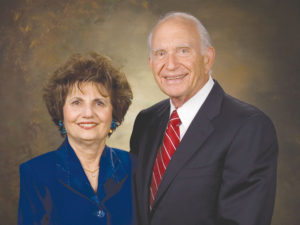
Dr. Arnold & Dianne Gazarian were to be honored at the Armenian Studies Program 32nd Annual Banquet on March 22. Through their philanthropy, the Gazarians have played an instrumental role in the flourishing of the Armenian Studies Program on campus.
Following is a brief history of the establishment of the Berberian Chair, provided by Dr. Dickran Kouymian.
History of the Berberian Endowed Chair
for Armenian Studies
Back in the 1980s, Fresno State’s Development Officer, Richard Francois, approached me about establishing an Endowed Chair for Armenian Studies. My first question was, were there any endowed chairs at our University, no he said. Since I was a tenured full professor, my second ques-tion was why would I need to endow a Chair? He replied, “Well when you retire or if you should leave before, what guarantee do you have that the university will search for a replacement in Armenian Studies?” It seemed to me that the answer to why was self-evident; there was a large and generous Armenian community attached to the University and hiring a replacement in my field would be natural, if not automatic. Francois was not convinced and at my insistence began to do some research on the subject of endowed chairs in the California State University system. So did I.
The first discovery was that among the 22 campuses in the system at the time, there was only one endowed position and that was not really a full endowment, at California State University, San Francisco, if my memory serves me well. The next question I posed was obvious: how much are we talking about? Richard Francois had no idea, so I encouraged him to ask the Chancellor’s Office, but they had no idea either, though they sent a two-paged prepared document about such an eventuality. Somehow with no apparent justification, a sum of $300,000 was put forth.
Two separate avenues toward such an endowment seemed essential. The first was to establish an Armenian Studies Advisory Board from among important members of the Fresno Armenian community, which was done with great care and lots of advice from those involved. I felt the Armenian Studies Program had to have such a body both to represent the Program and back it. I was saddened when the Advisory Board was eventually dissolved. Secondly, I decided to ask for the contracts and details of the endowed chairs of Armenian Studies at Harvard, Columbia, and the University of Michigan. I noticed that not one of the agreements I was able to get a copy of had a protection guaranteeing that the endowment income would only be used for Armenian Studies. In fact, many older endowments, including ones centuries-old at British Universities were now being used in any way the administration wished.
With this information I, and the Advisory Board, drew up a contract with the University in which it was clearly stated that the funds were to be raised for an Armenian Studies Endowed Professorship. If in the future a time came when Armenian Studies was no longer taught at Fresno State, then that endowment money had to be transferred to an American University where Armenian Studies was taught. If eventually, a century or so later, Armenian studies was no longer taught at a university, the endowment was to be transferred to a recognized Armenian charitable institution, I believe the Armenian General Benevolent Union (AGBU) was specifically mentioned as an example.
The announcement of an endowment fund drive was made at the following Armenian Studies Annual Banquet where more than $10,000 was raised, including a generous $1,000 donation by University President Harold Haak. It was shortly after this that Arnold Gazarian and I were chatting one afternoon in the hallway of the Leon Peters Business Building Auditorium when Arnold asked me what it would take to name the Chair. Once again, I said I had no idea and found out that Richard Francois had none either. Ultimately, I took the logical approach that half the project endowment target of $300,000 plus one dollar would allow the donor to designate a name. Thus, Arnold and Dianne Gazarian chose to donate $151,000 and name the chair after Dianne’s father and his father-in-law Haig Berberian and his wife Isabel. The rest of the fund drive scheduled to take a couple of year took only a few months, thanks to community members like Sarkis Sahatdjian, who drove me around the valley to solicit funds from Armenian farmers. The rest is history, and very happy history indeed.
Dickran Kouymjian
25 February 2020, Paris
 Hye Sharzhoom Armenian Action
Hye Sharzhoom Armenian Action